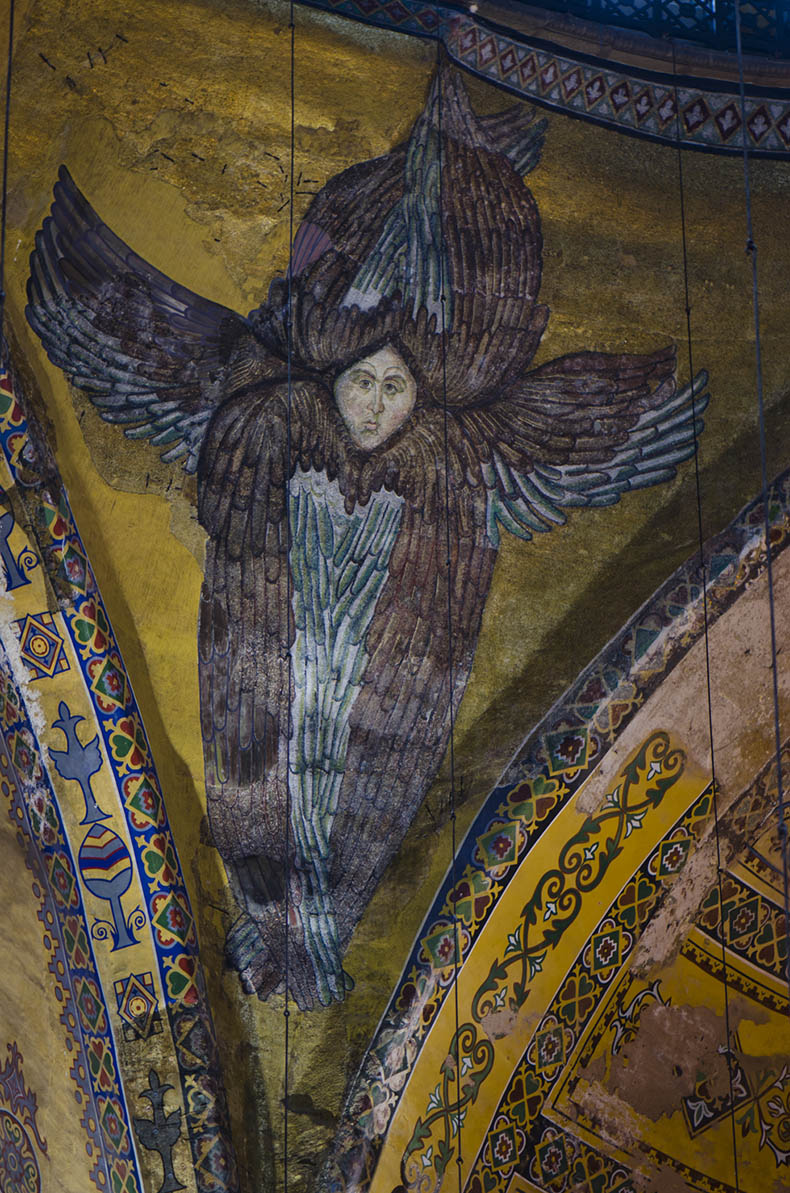 ALERT! June 2020 - Turkey's President Erdogan announces Hagia Sophia will be closed and reopened as a mosque on July 2! The mosaics will be painted over, beginning with this one. News reports say the seraphim is already gone. Can you believe this is happening? What can be done???
ALERT! June 2020 - Turkey's President Erdogan announces Hagia Sophia will be closed and reopened as a mosque on July 2! The mosaics will be painted over, beginning with this one. News reports say the seraphim is already gone. Can you believe this is happening? What can be done???
First, what is a Seraphim? The following is a description of angels from "A Readers Guide to Orthodox Icons". Below is a picture of a mosaic encrusted vault in Cefalu Cathedral in Sicily showing many-winged Seraphim which was made by Byzantine artists from Constantinople for the Norman Kings of the island:
"The name given, seraphim, is Hebrew and means “burning ones” (plural; the singular form is seraph). They are the closest to the throne of God, and as such are flame-like, “For our God is a consuming fire.” (Heb 12:29); “His throne was a flame of fire” (Dan 7:9); “the appearance of the Lord was like a blazing fire” (Ex 24:17). The seraphim, then, are usually painted in icons in red, signifying this flame. The six wings are arranged in a particular way: two pointing down (covering the feet), two up (covering the face), and two outstretched (in order to fly). They are also frequently found surrounding images of Christ in glory. In the 14th century fresco by Theophanes, the Seraph is shown holding a flabellum or hagion ripidion (lit. “sacred fan”) upon which are the words “holy, holy, holy” in Greek: the same thrice-holy hymn used in Isiah’s description of these angels."
"As a side-note, these “sacred fans” are still ceremonially used in the Divine Liturgy today, to protect the body and blood of Christ and as a sign of honor (think of Cleopatra reclining whilst a flunky next to her waves a huge fan). Often these Liturgical fans have an image of a seraph on them, to remind us that God is indeed present in the chalice; the same God who is surrounded by the seraphim who fly about Him."
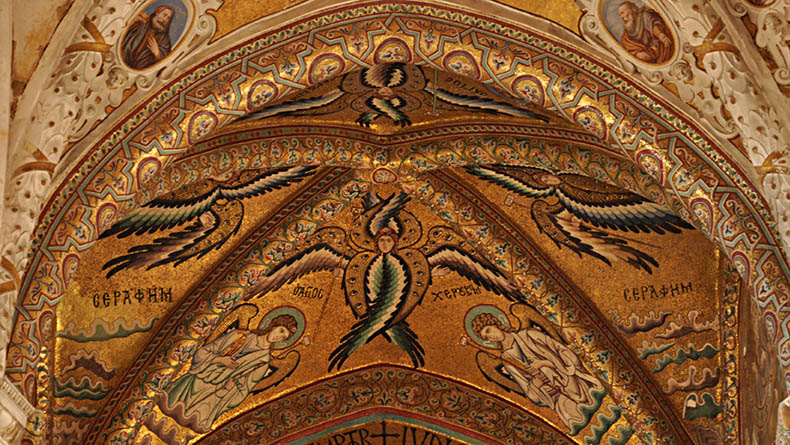
There were 16 Serifs and Cherubim in Hagia Sophia. All of them were enormous - 20 ft tall or more. 4 were in the nave pendentives and 12 were in the golden vaults of the South Gallery near the Deesis. The image above gives you an idea of what they would these heavenly creatures that serve and worship God would have looked like there. There were images of Cherubim on the Ark of the Covenant and throughout the sanctuary in the Jewish temple in Jerusalem, where the High Priest offered incense to them on high holy days. Thus images - even sculptures - of them have been sanctioned by God Himself since the beginning. Hagia Sophia was built to emulate Solomon's Temple as a shrine for the worship of God and the city of Constantinople an earthly substitute for the Heavenly Jerusalem.
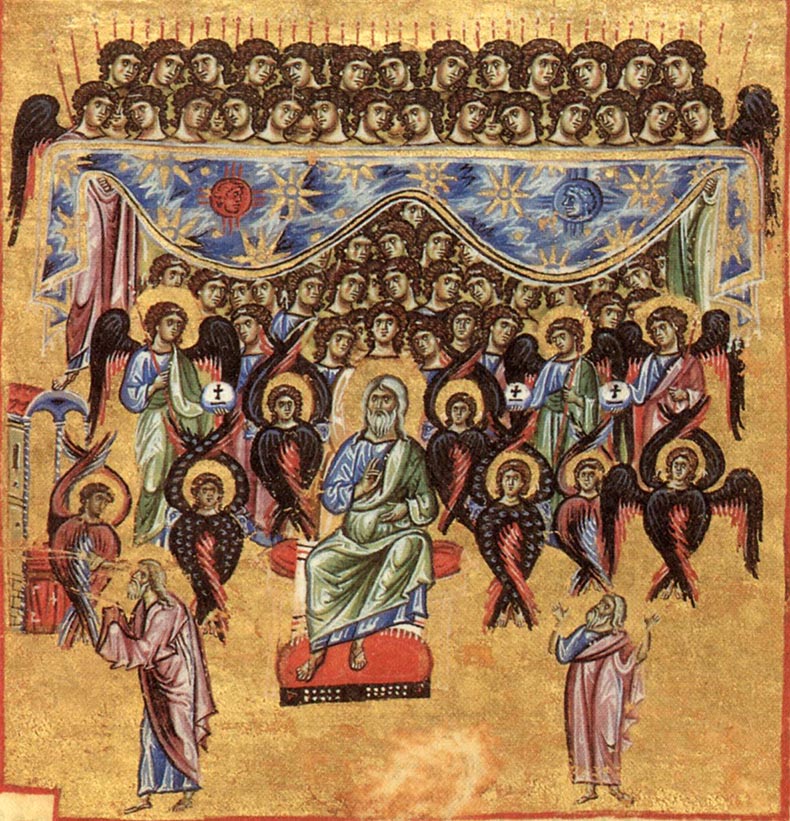
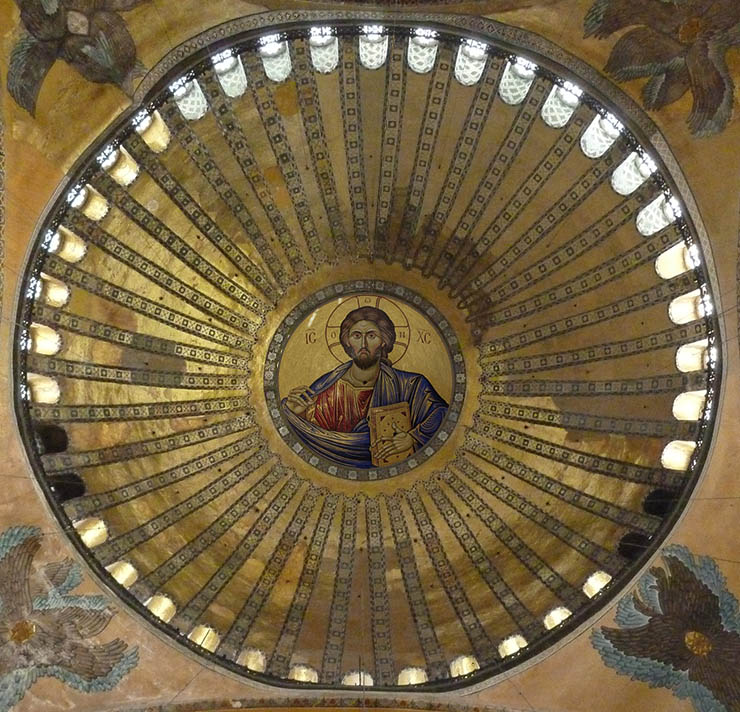
In 1347 the eastern arch, part of the dome and part of the eastern pendentives were damaged. A few years before serious cracks had developed in the eastern arch and semi-dome after an earthquake. Nothing was done to repair the damage - mosaic and chunks of mortar and brick were falling into the sanctuary and damaging the chancel screen and altar. It was also dangerous for the clergy working in the church. Finally a great part of the dome and eastern arch fell into the church doing enormous damage to the chancel screen and destroying all of the icons along with the chancel screen, the altar with the great arched ciborium and wrecking the solea and part of the ambo.
When the ceiling collapsed it damaged a large area on the floor of the church along with parts of the iconostasis and ambo. All of the icons were destroyed. Although the city of Constantinople and its elite merchants and noble families were quite wealthy the Imperial Court of the time was not. The restoration of the church was an expensive project and an massive engineering effort that lasted for seven years. Funds had to be raised from foreign sources, including the Tsar of Russia. Once can imagine the perilous condition of the church just after the collapse and during the long restoration. Until the arch and dome had been stabilized and reconstructed any earthquake could have brought down the rest of the vaulting.
The seraphim angels in the eastern pendentives date from the 1347 rebuilding of the great eastern arch, the eastern part of the dome and other vaults. From the suture lines in the plaster, each line represents a day's work, it looks like each seraphim took less than a week to make. They are each unique in the design of their wings. The faces are 4ft tall. There is no explanation for the difference between the wings which must be intentional. The south (right facing the apse) seraphim's wings are much thicker (shall we say less elegant?) - than the other. It has more feathers and the colors are reversed. The wings on the top are open - not crossed like the left one. The colors are different, too. The left one has blue feathers and the right green ones. It would be interesting to know which one was first and if two different artists were involved. The mosaic seraphim in the western pendentives have vanished. They must have disappeared before 1710 because Loos does not include them in his drawings of that time. However, Antoniades reports that considerable fragments of the western seraphim were still visible in 1894 when he saw them. After the earthquake these traces were destroyed in the reconstruction works. When they were covered over by the Fosattis they were painted in new horrible, clunky designs in flat oil paints and new 'gothic-style' ornaments were added. They are obviously supposed to be copies of the eastern seraphim. If so, they are dreadful copies. Perhaps their workers were unsupervised when they created them. The contrast between the Byzantine and Ottoman seraphim is so obvious that this must have been apparent when they were unveiled. There is no way those heavy Ottoman seraphim (the Ottomans thought they were bats) could have flown! We know the western arch was completely replastered after the 1894 earthquake and all of the surviving mosaics there (Virgin and Child and two saints, Peter and Paul) were were destroyed. The objective of the restoration was not to preserve the Christian art of old Byzantium, but to return Hagia Sophia to service as a mosque as soon as possible. The painted seraphim we see there must date post-1894. We can easily tell the difference between Fosatti plaster which is painted a horrible dark mustard - and plaster from 1894+ which is bright yellow-orange. Perhaps the artists who painted them thought they were supposed to create images of bats!
A strong resemblance has been has been drawn between the face of the left Seraphim and the famous icon of St. Michael Archangel which was painted at the the same time. Some believe that the same artist was responsible for both angels. Compare them below. I think I agree.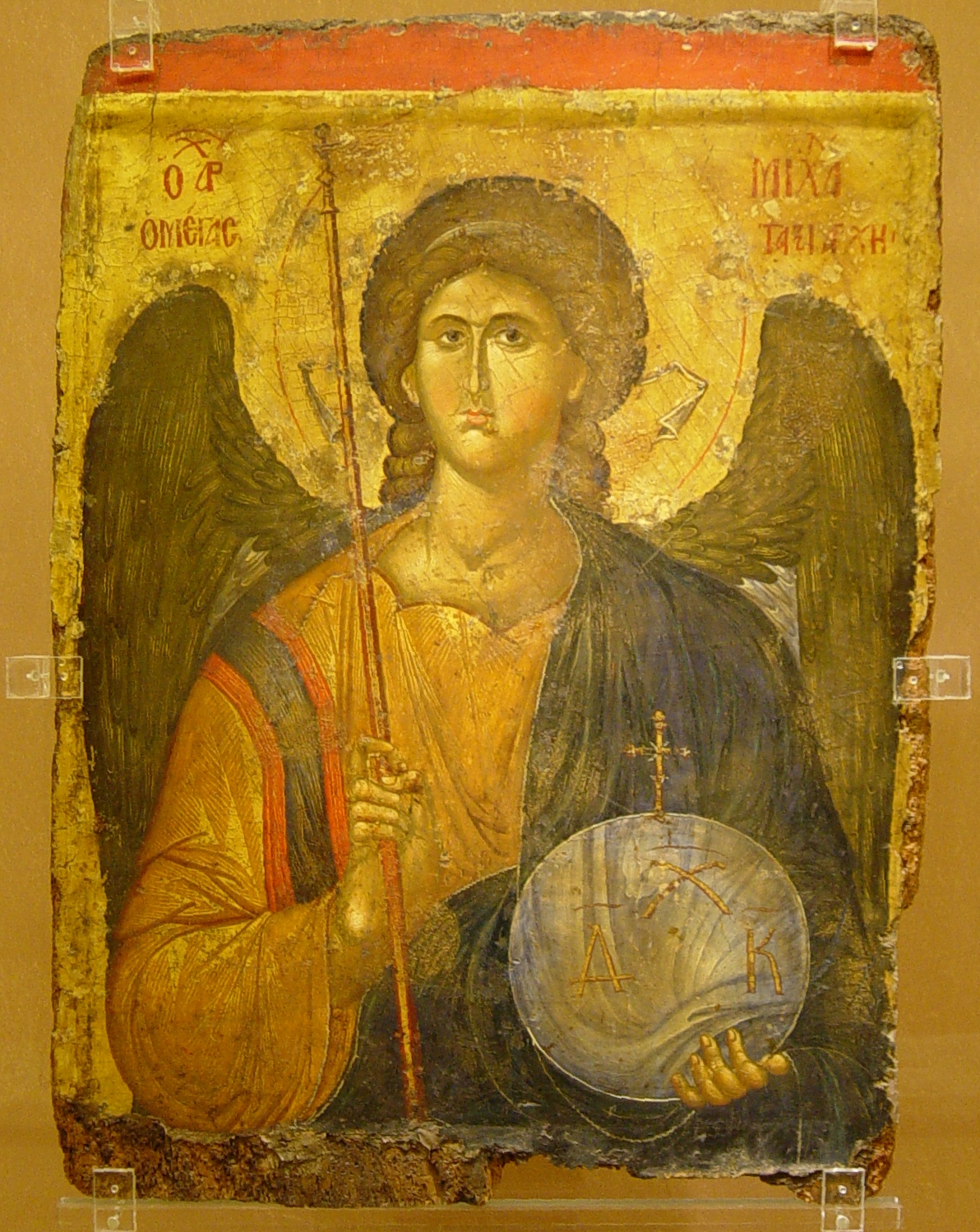
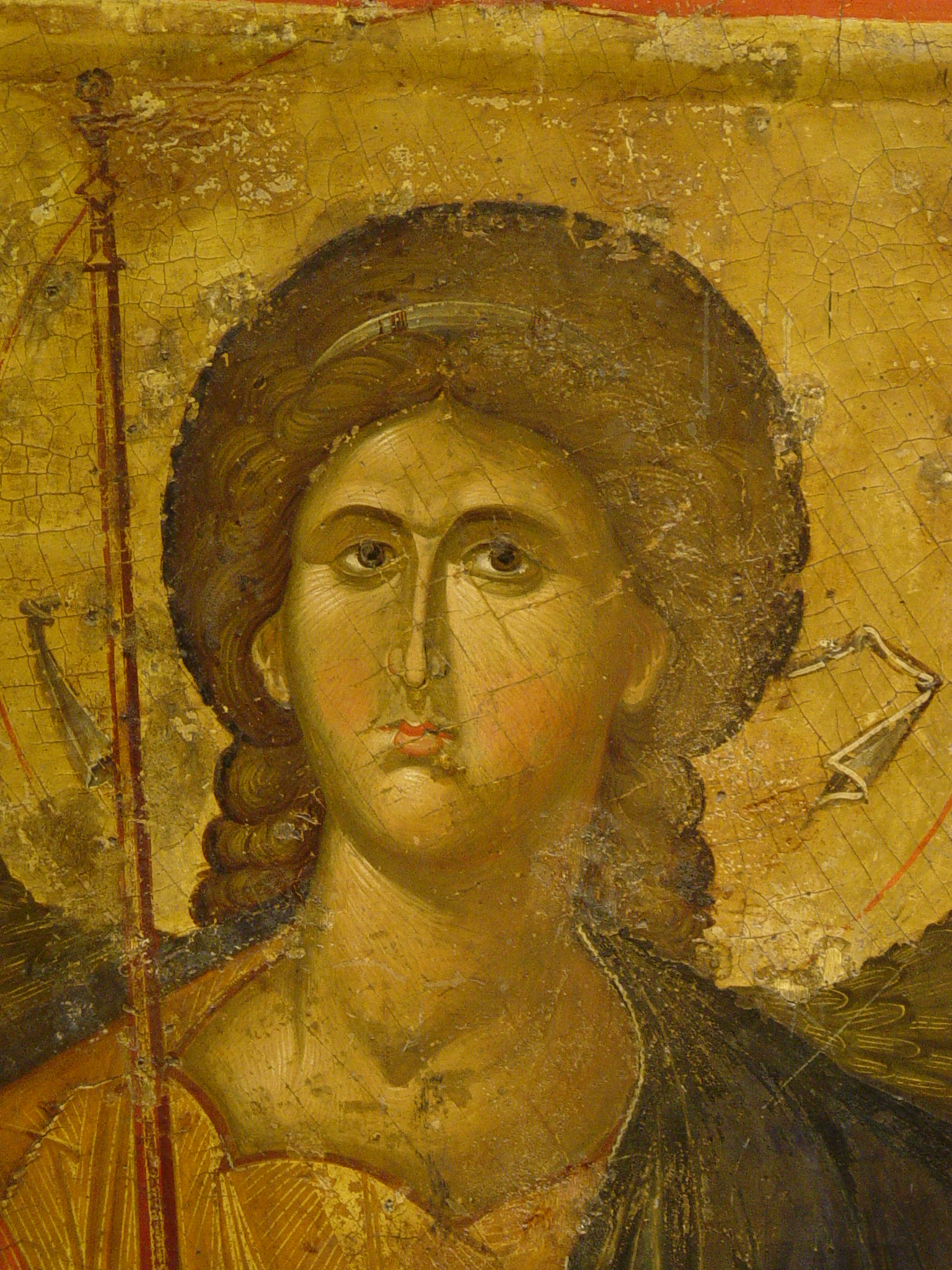
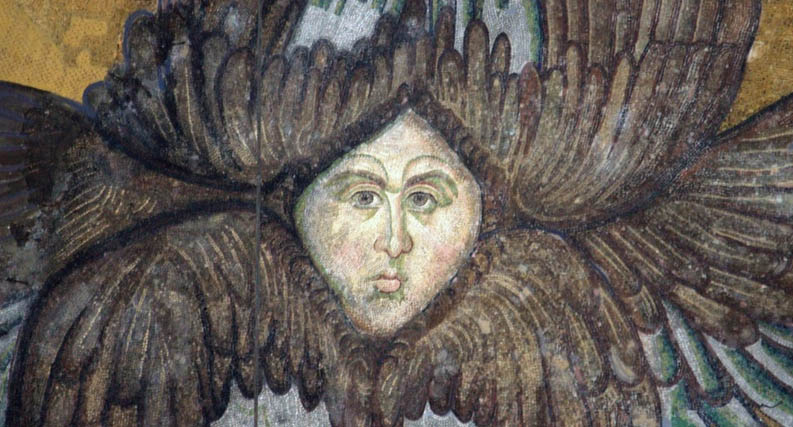 Notice how small feathers have been placed around the face.
Notice how small feathers have been placed around the face.
At first glance it appears the restoration was not perfect and the eastern vaults and dome seem to show the scars of the repairs, which are irregular and damaged their symmetry. This is particularly noticeable - and disturbing - to modern visitors to the museum who don't know the circumstances of the repairs and the capabilities of the engineers of the time. Recent study of the dome and the restoration of 1346 has shown that the 14th century engineers and master masons followed the exact line of the pre-existing bulge in the dome cornice. They were not responsible for this major imperfection in the fabric of the building. Although the repairs were shoddy and done cheaply they have lasted 600 years of more earthquakes.
Hagia Sophia has many irregularities that date from the construction of the church which was finished during a period of reduced daylight caused by a 6th century volcanic eruption. Scientists tell us that there were only 3 hours of daylight during a period of about three years. This occurred right in the middle of the building of Hagia Sophia. This is the exact time we see a sudden decline in the quality of finished carving and mosaic decoration, particularly in remote parts of the building that would have already seen less natural light. We can be sure that lamplight was used, but that was no substitute for natural daylight. The mistakes caused by this natural disaster would not have been apparent until after the darkening of the light of the sun had ended. Then it would have been too late to fix anything.
There are also many distortions in the building that are due to the settling of the foundations and the movement of various arches and walls as their brickwork and mortar dried. This resulted in many columns being set alarmingly askew, which made the building appear to be in danger of collapse. One of the things the Fossattis did in their renovation of Hagia Sophia was to right many of these, but there are still a few places were you can see the ones they didn't do.
The mosaic of the Seraphim was added in the final restoration of the damage of 1348, which took a long time to complete. The face is around 4 ft tall and can be easily seen from the floor of the church.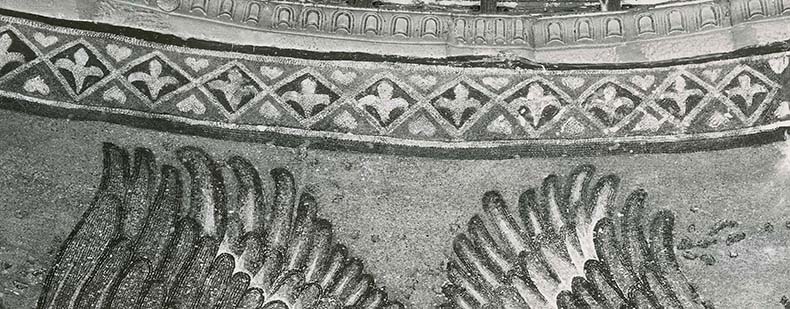
Above you can see the tips of the wings of the Seraphim on the right side of the apse in a black and white image from 1960 taken by Robert van Nice. They are as nicely done as the one on the left side of the apse. The one on the right may not have damaged in the 14th century earthquake and did not need to be replaced. It seems to be more finely executed. The left Seraphim had a couple of shades of blue glass mosaic to make the with wings, which made it difficult to model with any fineness. The more shades you have in blue the more graduated the tones can be made. It also seems there was a shortage of blue glass mosaic cubes because the cubes are widely spaced to make them go further.
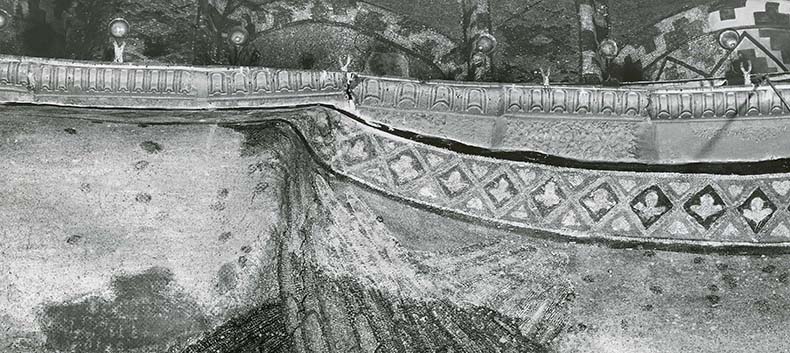 In the image above you can see the tips of the Seraphim on the left, the one whose face was revealed. You can see the bad join between the 14th century repair and rest of the pendentive and dome cornice. Below is an image showing both Seraphims so you can compare the wings.
In the image above you can see the tips of the Seraphim on the left, the one whose face was revealed. You can see the bad join between the 14th century repair and rest of the pendentive and dome cornice. Below is an image showing both Seraphims so you can compare the wings.
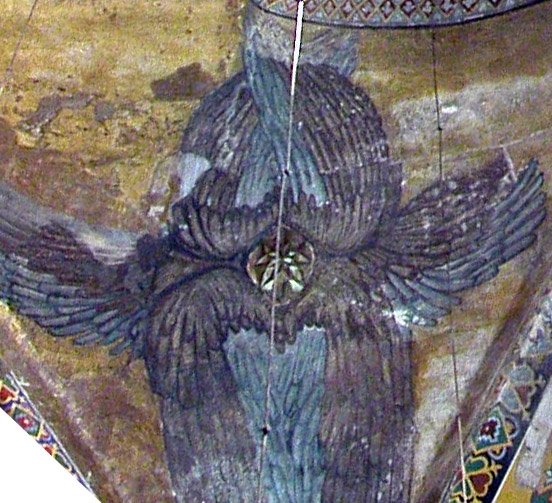 Above: Here's a view of the pendentive before it was cleaned and the star removed. You can see large patches of Fossati plaster work to fill in lost areas of mosaic, especially on the left above the wing.
Above: Here's a view of the pendentive before it was cleaned and the star removed. You can see large patches of Fossati plaster work to fill in lost areas of mosaic, especially on the left above the wing.

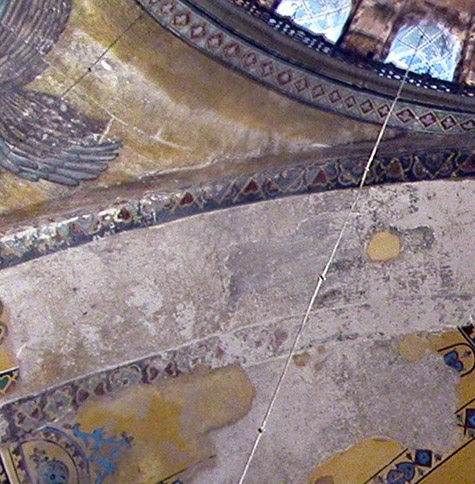
Above: Here you can see a mosaic setting bed in the on the north side of great eastern arch of Hagia Sophia with the remains of a standing Virgin and Child dating to 1354. The gold mosaic has been scraped off - the mosaic has been badly mutilated on purpose. When did it happen - it must have been some time after 1850 when the Fossatti brothers saw and recorded it. We also have the watercolors and drawings of Saltzenberg from the same period.
Below her are the traces of a mosaic portrait of the Byzantine Emperor John V Palaeologus dating from 1354. This mosaic was discovered in 1989, but has not been completely uncovered. John reigned from 1341 to 1391. In the top center of the arch was a representation of the Throne of God. Fragments of figures - a Virgin and Child with Saints Peter and Paul, were found by Fossati in the western arch as well, but they seem to have been totally lost. I found this text on the web along with the picture below:
In 1989, a huge scaffold was erected in the eastern arch of Hagia Sophia to repair loose plaster. The workers had noticed mosaic tesserae in the arch and Tauss was asked to examine them. Upon climbing to the top of the scaffold and examining the exposed mosaics, Tauss verified the identification of the mosaics, which depicted a Hetoimasia, the Virgin, St. John the Baptist, and John V Paleologus, who had funded the restoration of the building after a series of earthquakes in 1345. These mosaics had not been seen or documented since 1847, when Gaspare Fossati quickly sketched them before they were re-covered with plaster during the restoration campaign commissioned by Sultan Abdülmecid I. Tauss consulted with Cyril Mango, who was also in Istanbul at the time, and also with two conservators from the Austrian Academy of Science, Peter Berzobohaty and Claudia Podgorscheck, who were working on the Great Palace mosaics next door. They discussed technicalities and the possibility of funding and support for the conservation of the Paleologian mosaics in Hagia Sophia. Tauss suggested it was necessary to install an elevator to accommodate the work. It would work as a pulley lift and could take people and materials to the work area. The enormous estimated cost for the project was probably what kept it from ever happening. The mosaics in the east arch still haven’t been conserved and are barely visible to visitors because they are so high from the floor. There is no known publication about the 1989 re-discovery; Tauss said he would not publish his photographs of the mosaics without permission from the Directorate of the Hagia Sophia.
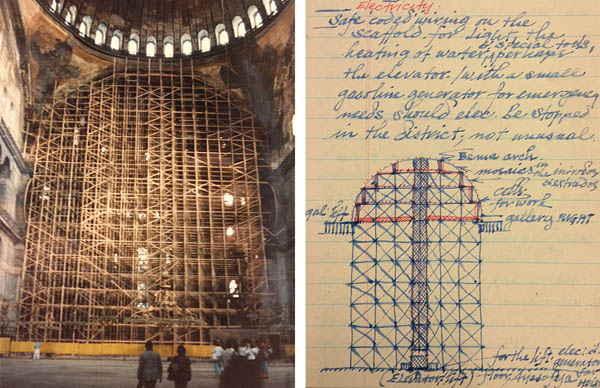
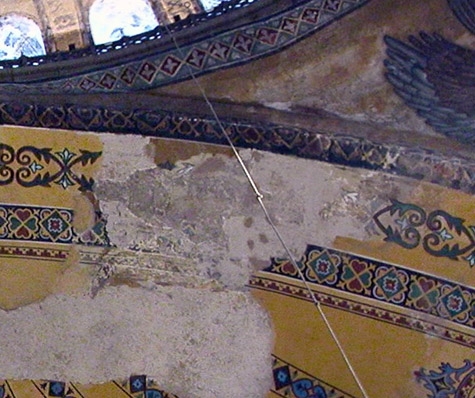
Above you can see the traces of a mosaic of St. John the Baptist, below him would have been a portrait of John's wife Helena Kantakouzene. I never can quite figure out what the condition of these mosaics is. Is all that's left a setting bed?
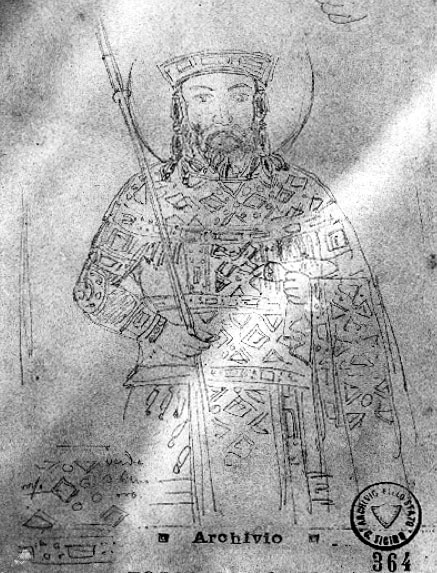
Above: Fossati drawing of the mosaic of John V on the north side of the great eastern arch.
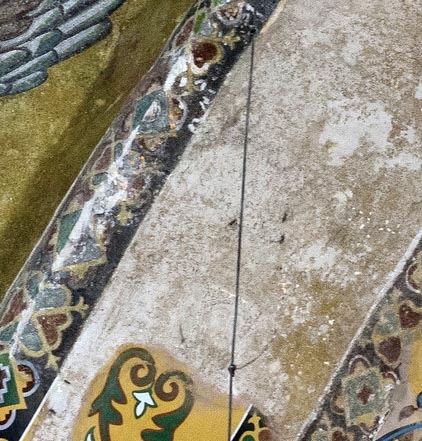
Above: Just behind the cable and above a patch of painted plaster is the ghostly image of the head of John V Palaeologus in Hagia Sophia, with a beard, crown and halo. he looks better here than in the Fossatti drawing.
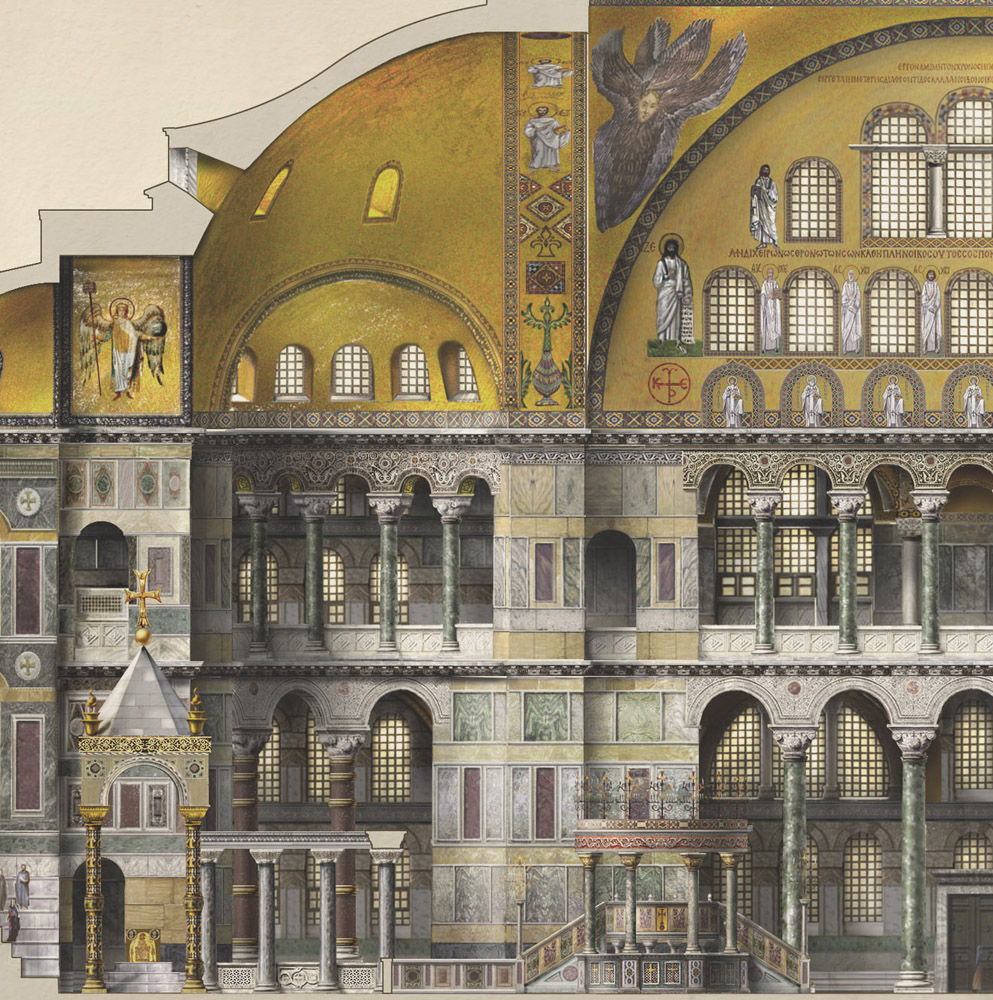
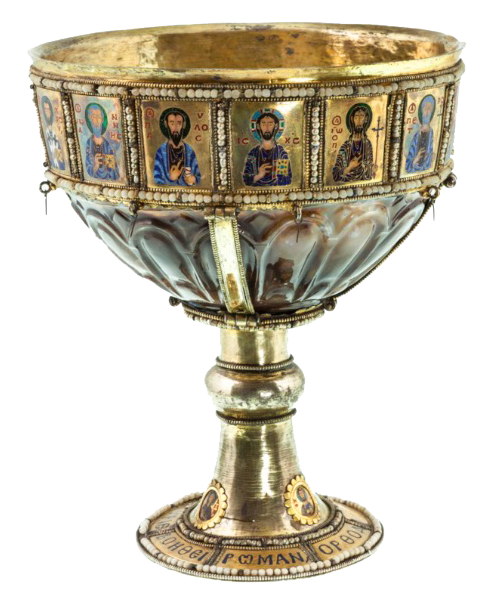 Silver, Gold, Enameled Icon with Lapis & Jewels
Silver, Gold, Enameled Icon with Lapis & Jewels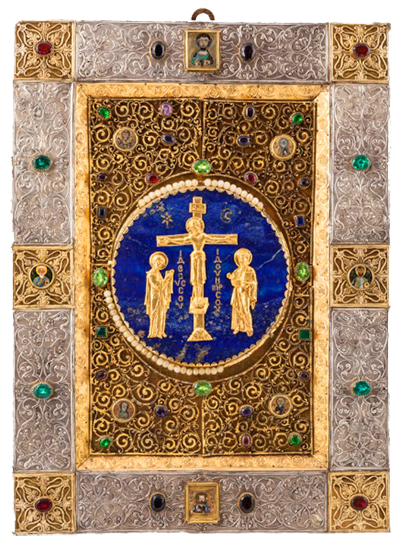







 Notice how small feathers have been placed around the face.
Notice how small feathers have been placed around the face.
 In the image above you can see the tips of the Seraphim on the left, the one whose face was revealed. You can see the bad join between the 14th century repair and rest of the pendentive and dome cornice. Below is an image showing both Seraphims so you can compare the wings.
In the image above you can see the tips of the Seraphim on the left, the one whose face was revealed. You can see the bad join between the 14th century repair and rest of the pendentive and dome cornice. Below is an image showing both Seraphims so you can compare the wings. Above: Here's a view of the pendentive before it was cleaned and the star removed. You can see large patches of Fossati plaster work to fill in lost areas of mosaic, especially on the left above the wing.
Above: Here's a view of the pendentive before it was cleaned and the star removed. You can see large patches of Fossati plaster work to fill in lost areas of mosaic, especially on the left above the wing.









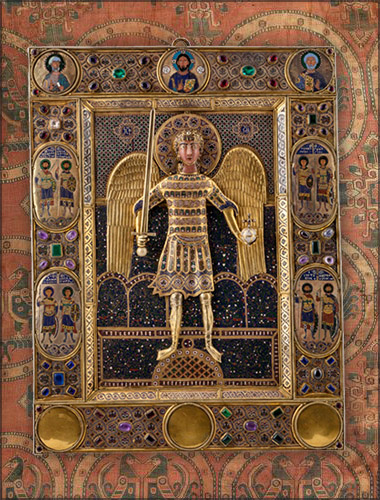

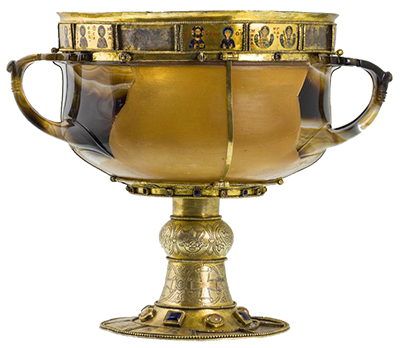
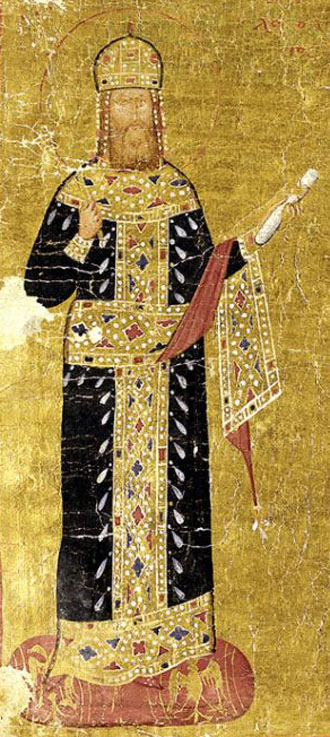
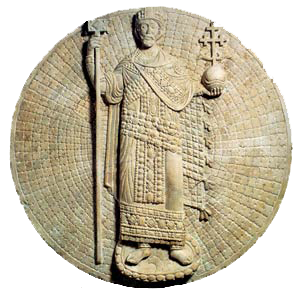
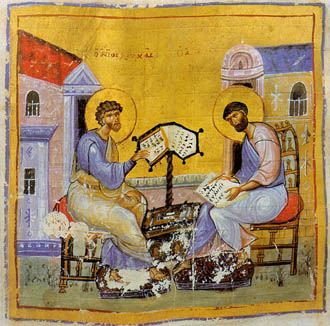
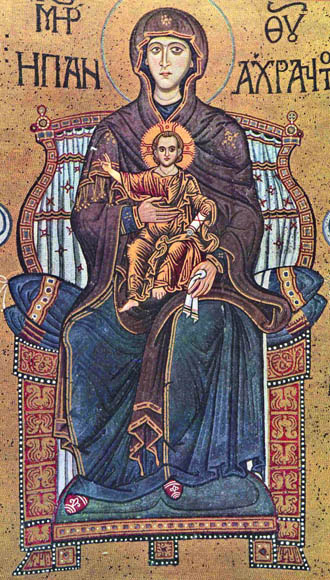
 click here for icons of christ
click here for icons of christ click here for icons of the theotokos
click here for icons of the theotokos click here for icons of angels
click here for icons of angels click here for icons of saints
click here for icons of saints








